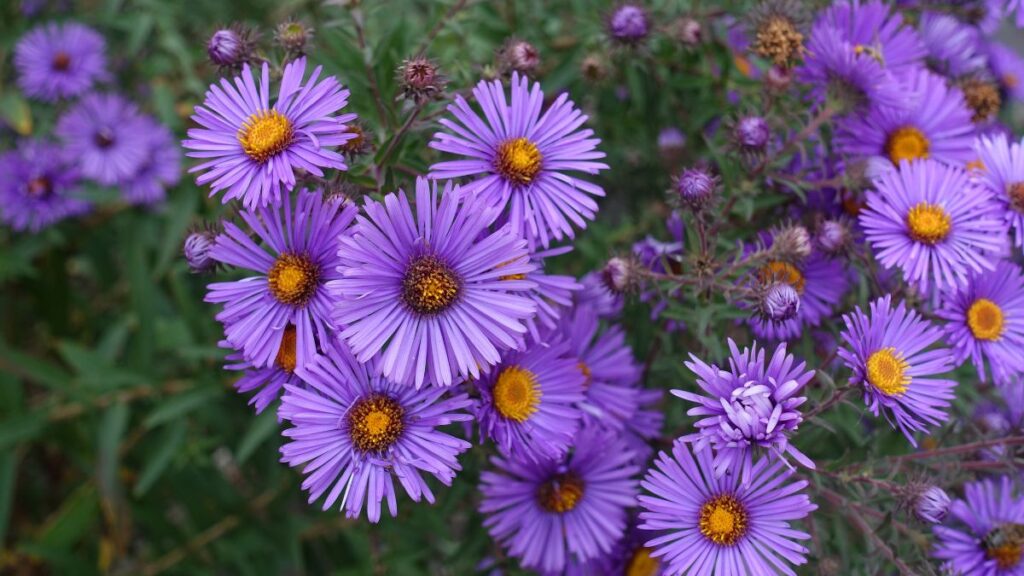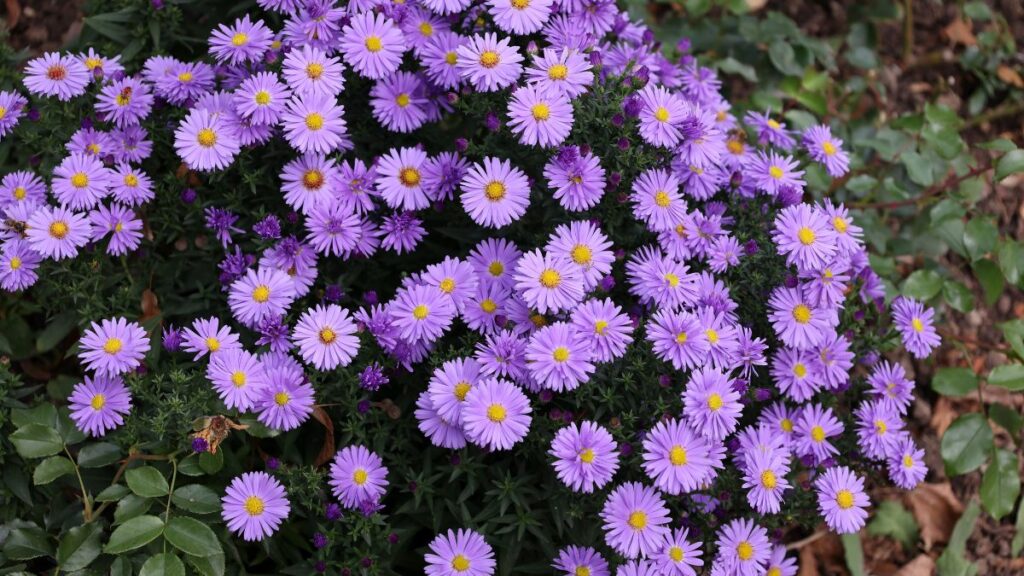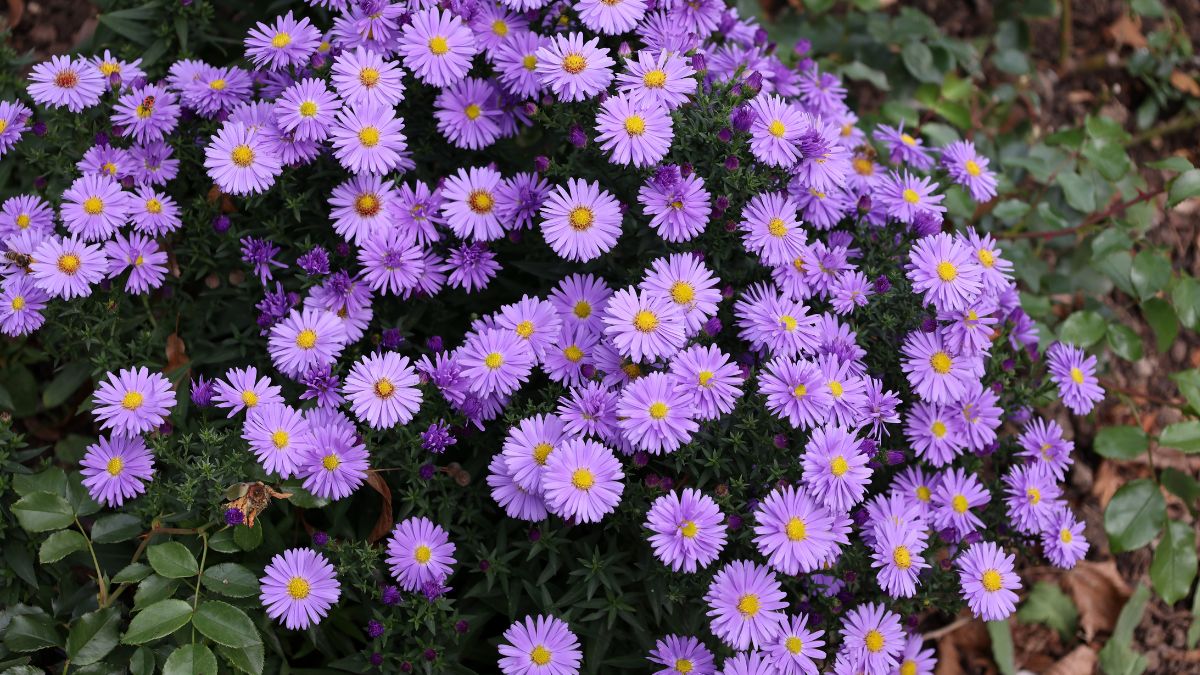Introduction
Aromatic Aster Plant
Aromatic Aster Plants, scientifically known as Symphyotrichum oblongifolium, is a native perennial plant found in North America. Known for its charming blue to purple daisy-like flowers, this plant adds aesthetic appeal and ecological value to any landscape.

Characteristics of Aromatic Aster Plant
Aromatic Aster typically grows in clumps, reaching about 1 to 3 feet and spreading equally wide. Its narrow, lance-shaped leaves emit a pleasant aroma when crushed, hence the name “aromatic.” The flowers bloom profusely in late summer and fall, attracting pollinators like butterflies and bees.
Benefits of Aromatic Aster Plant in Sustainable Landscaping
Drought Tolerance
One of the remarkable features of Aromatic Aster is its ability to withstand drought conditions once established. This makes it ideal for xeriscaping and regions prone to water scarcity.
Wildlife Attraction
The nectar-rich flowers of Aromatic Aster serve as an important food source for various pollinators, including bees and butterflies. You can support local wildlife populations by incorporating this plant into your landscape.
Soil Improvement
Aromatic Aster has deep taproots that help improve soil structure and prevent erosion. Additionally, its ability to thrive in poor soils makes it a valuable asset for reclaiming disturbed or degraded areas.

How to Grow Aromatic Aster Plant
Soil Requirements
Aromatic Aster prefers well-drained soil with a neutral to slightly acidic pH. It can tolerate a wide range of soil types, including sandy or clay soils, as long as they are not waterlogged.
Sunlight and Water Needs
Plant Aromatic Aster in a location that receives full sun to partial shade. While it is drought tolerant once established, regular watering is necessary during the first growing season to help the plant establish a strong root system.
Planting and Care Tips
Plant Aromatic Aster in the spring or fall, spacing them about 1 to 2 feet apart. Incorporate organic matter into the soil before planting to improve fertility and drainage. Mulching around the base of the plant can help retain moisture and suppress weeds.
Companion Planting with Aromatic Aster
Aromatic Aster pairs well with other native perennials and grasses, such as Black-eyed Susan (Rudbeckia spp.), Coneflower (Echinacea spp.), and Little Bluestem (Schizachyrium scoparium). These companions complement its aesthetic appeal and provide additional ecological benefits.
Aesthetic Appeal of Aromatic Aster in Landscaping
With its profusion of delicate blue to purple flowers, Aromatic Aster adds a pop of color to any garden or landscape. Whether planted en masse or mixed with other perennials, it creates a stunning visual display from late summer through fall.
Maintenance and Pruning Tips
Aromatic Aster is a low-maintenance plant that requires minimal care once established. Deadheading flowers can prolong the blooming period and promote a tidier appearance. Cut back the stems to about 6 inches above ground level in late winter or early spring to encourage new growth.
Common Pests and Diseases
While generally pest and disease-resistant, Aromatic Aster may occasionally suffer from aphid infestations or powdery mildew. Monitor the plant regularly and address any issues promptly with organic pest control methods or fungicides if necessary.
Aromatic Aster Varieties
Several cultivars of Aromatic Aster are available, offering variations in flower color, height, and bloom time. Some popular varieties include ‘October Skies,’ ‘Raydon’s Favorite,’ and ‘Purple Dome,’ each with unique characteristics and attributes.

Using Aromatic Aster in Different Garden Designs
Whether in a formal garden, cottage garden, or naturalistic landscape, Aromatic Aster can be incorporated into various design styles. Its versatility makes it suitable for borders, mass plantings, rock gardens, and container gardening.
Harvesting and Preserving Aromatic Aster
Harvest Aromatic Aster blooms for floral arrangements or dried flower crafts when fully open but before they fade. Hang them upside down in a well-ventilated area away from direct sunlight to preserve their color and shape.
Aromatic Aster in Traditional Medicine
In addition to its ornamental value, Aromatic Aster has a history of medicinal use by Indigenous peoples. The leaves were brewed into tea and were believed to have medicinal properties, including anti-inflammatory and diuretic effects.
Sustainability and Eco-Friendliness of Aromatic Aster
By planting Aromatic Aster in your landscape, you enhance its beauty and contribute to environmental sustainability. As a native plant, it requires fewer resources and provides essential habitat and food for native wildlife.
Conclusion
In conclusion, Aromatic Aster stands out as a versatile and eco-friendly option for landscaping endeavors. Its delightful flowers, environmental advantages, and minimal upkeep need not only enhance the beauty but also the functionality of any garden or landscape design.

FAQs
Q1: Can Aromatic Aster grow in containers?
Yes, Aromatic Aster can be grown in containers with adequate drainage and sunlight.
Q2: How often should I water an Aromatic Aster?
Once established, Aromatic Aster is drought tolerant and only requires occasional watering during prolonged dry spells.
Q3: Is Aromatic Aster invasive?
No, Aromatic Aster is not considered invasive. It is a native plant that plays a beneficial role in its ecosystem.
Q4: Can I divide Aromatic Aster?
Yes, Aromatic Aster can be divided in the spring or fall to propagate new plants and rejuvenate older ones.
Q5: Does An Aromatic Aster attract deer?
While deer may browse on Aromatic Aster occasionally, it is not their preferred food source due to its aromatic foliage.
